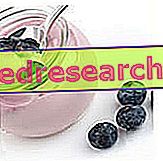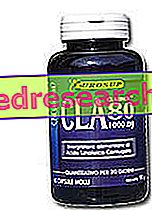Watch the video
X Watch the video on youtubeThe anti- candida diet aims to prevent the excessive proliferation of this micro-organism, taking away its nourishment and strengthening the body's immune defenses.
What is Candida?
Candida albicans is a saprophytic fungus commonly found in the oral cavity, in the gastrointestinal tract and in the vagina; the adjective saprophyte emphasizes its ability to benefit from the human body without harming it or bringing benefits.
The proliferation of candida is in fact controlled by the immune system, by the probiotic bacteria that populate the intestine and by the lactobacilli of the vaginal flora. Only when these defenses are undermined by factors such as severe stress, the use of antibiotics and excessive vaginal hygiene, candida takes on pathological connotations; in this case one speaks of candidiasis, a disease whose manifestations can affect the skin, vagina, skin and, in immunocompromised individuals such as advanced HIV in the advanced phase, the whole organism.
An Important Introduction
Many proponents of holistic medicine believe that the overgrowth of candida in the human gut (intestinal candidiasis) is responsible for symptoms such as depression, bad mood, fatigue, memory loss, headaches and excessive need for sweets.

The same authors try to remedy the problem through a series of dietary rules, useful for rebalancing the local microflora and reducing the number of these fungi.
These rules represent the foundations on which the white diet is proposed for the first time to the general public through the book The Yeast Connection: A Medical Breakthrough by Crook, WG, released in the United States in 1983.
Before examining the principles on which it is based, let's start by saying that there is no certainty about the usefulness of this diet, nor about the link between the above symptoms and intestinal candidiasis.
On the other hand, excessively reducing the variety of foods consumed risks not only making food monotonous, too restrictive and as such difficult to follow, but also causing - in the long run - nutritional deficits of no small importance. For this reason, before embarking on the candida diet, it is very important to contact an expert on the subject, such as a doctor or a nutritionist.
What to eat
Foods to Avoid
The basic rules of any diet to defeat candida require the removal of sugars, alcohol and foods rich in yeasts and mycotoxins.
For this reason, on top of the "black list" we find sucrose, fruit (both sugary and dried), most cereals, sugary and alcoholic beverages (especially beer), smoked foods or foods rich in preservatives. peanuts, vinegar, bread (as long as unleavened) and hard cheeses.
Useful foods
On the other hand, the candida diet encourages the consumption of unsweetened yogurt (as a food rich in useful bacteria for bowel health), specific probiotic and prebiotic formulations, garlic, turmeric and various foods fermented like miso or kefir.
Allowed fish, eggs, lean meat, olive oil and other seed oils, brown rice, seaweed and vegetables (well washed).
Supplements
The anticandida feeding gives much space to some integrators, like the already mentioned probiotics (above all bacteria of the genus Lactobacillus ), prebiotics (FOS and inulin), caprylic acid, sorbic acid and sorbates, and complements based on soluble fibers (pectin, rubber of guar, psyllium and linen seeds).
Phytotherapy, for its part, suggests the use of
- some essential oils (oregano, mint, thyme and melaleuca), to be taken exclusively in the form of opercula (if not carefully dosed they are very dangerous);
- adaptogenic drugs - immunostimulants, such as the uncaria tomentosa, the pau d'arco and the echinacea;
- , choleretic drugs - cholagogues, such as turmeric or artichoke, carminative drugs;
- like fennel, cumin and anise;
- antibacterial drugs, such as propolis, and the dried rhizome of Hydrastis canadensis.
Duration of the Diet
The duration of the candida diet depends on the general health of the body, the severity of the symptoms and their duration; in this regard there are conflicting opinions, but people who successfully respond to diet therapy state that it is necessary to follow it for at least four weeks before seeing the first results. For many others we talk about months.
The food choices of the first weeks are particularly rigorous, so much so that the overall carbohydrate intake can fall below 60 grams. Of course, we must take into account the above factors, as well as the sex, body structure, physical activity and initial weight of the patient.
Always in these preliminary phases, it can happen that the symptoms get worse, both because the body is slowly getting used to the new diet, and because the body is "flooded" with toxins from the dying microorganisms.
As the symptoms improve, the anticandida diet can become less strict, but to avoid recurrences it is good to continue to moderate the consumption of simple sugars and carbohydrates with a medium glycemic index.



